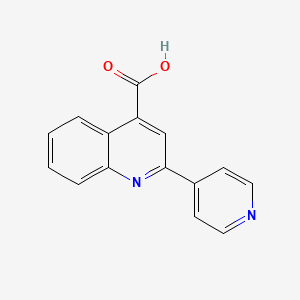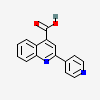2-(Pyridin-4-yl)quinoline-4-carboxylic acid
- 14228-23-0
- 2-(pyridin-4-yl)quinoline-4-carboxylic acid
- 2-(4-pyridinyl)-4-quinolinecarboxylic acid
- 2-pyridin-4-ylquinoline-4-carboxylic acid
- 2-Pyridin-4-yl-quinoline-4-carboxylic acid
- Create:2005-03-26
- Modify:2024-12-28

- 14228-23-0
- 2-(pyridin-4-yl)quinoline-4-carboxylic acid
- 2-(4-pyridinyl)-4-quinolinecarboxylic acid
- 2-pyridin-4-ylquinoline-4-carboxylic acid
- 2-Pyridin-4-yl-quinoline-4-carboxylic acid
- 4-Quinolinecarboxylic acid, 2-(4-pyridinyl)-
- NSC360211
- CINCHONINIC ACID, 2-(4-PYRIDYL)-
- MFCD00687610
- NSC-360211
- CHEMBL415737
- 2-(4-Pyridyl)cinchoninic acid
- NSC 360211
- 2-(4-Pyridyl)cinchoninsaeure [German]
- BRN 0017972
- 2-(4-Pyridyl)cinchoninsaeure
- 2-(4-pyridyl)quinoline-4-carboxylic acid
- Kyselin 2-(4-pyridyl)-cinchoninova [Czech]
- Kyselin 2-(4-pyridyl)-cinchoninova
- 8U2ZPK2XZA
- Cambridge id 5542580
- NCIStruc1_000902
- NCIStruc2_000832
- Oprea1_338008
- Oprea1_758729
- 5-25-05-00236 (Beilstein Handbook Reference)
- SCHEMBL116042
- DTXSID90161997
- IBXRRNLSWGROLA-UHFFFAOYSA-N
- ALBB-000774
- AR3149
- BBL009856
- BDBM50097097
- CCG-37557
- NCGC00014819
- NCI360211
- STK364547
- AKOS000121700
- AB06957
- NCGC00014819-02
- NCGC00014819-03
- NCGC00097920-01
- AS-45535
- NCI60_003280
- 2-(pyridin-4-yl)quinoline-4-carboxylicacid
- DB-042620
- CS-0116568
- 4-Quinolinecarboxylic acid, 2-(4-pyridinyl)
- EN300-00687
- AB00088210-01
- AB00088210-04
- SR-01000908315
- SR-01000908315-1
- Z56792374
- F1142-0435

H302 (100%): Harmful if swallowed [Warning Acute toxicity, oral]
H312 (100%): Harmful in contact with skin [Warning Acute toxicity, dermal]
H315 (100%): Causes skin irritation [Warning Skin corrosion/irritation]
H319 (100%): Causes serious eye irritation [Warning Serious eye damage/eye irritation]
H332 (100%): Harmful if inhaled [Warning Acute toxicity, inhalation]
H335 (100%): May cause respiratory irritation [Warning Specific target organ toxicity, single exposure; Respiratory tract irritation]
P261, P264, P264+P265, P270, P271, P280, P301+P317, P302+P352, P304+P340, P305+P351+P338, P317, P319, P321, P330, P332+P317, P337+P317, P362+P364, P403+P233, P405, and P501
(The corresponding statement to each P-code can be found at the GHS Classification page.)
Aggregated GHS information provided per 2 reports by companies from 2 notifications to the ECHA C&L Inventory. Each notification may be associated with multiple companies.
Information may vary between notifications depending on impurities, additives, and other factors. The percentage value in parenthesis indicates the notified classification ratio from companies that provide hazard codes. Only hazard codes with percentage values above 10% are shown.
Acute Tox. 4 (100%)
Acute Tox. 4 (100%)
Skin Irrit. 2 (100%)
Eye Irrit. 2A (100%)
Acute Tox. 4 (100%)
STOT SE 3 (100%)
Patents are available for this chemical structure:
https://patentscope.wipo.int/search/en/result.jsf?inchikey=IBXRRNLSWGROLA-UHFFFAOYSA-N
- ChEMBLLICENSEAccess to the web interface of ChEMBL is made under the EBI's Terms of Use (http://www.ebi.ac.uk/Information/termsofuse.html). The ChEMBL data is made available on a Creative Commons Attribution-Share Alike 3.0 Unported License (http://creativecommons.org/licenses/by-sa/3.0/).http://www.ebi.ac.uk/Information/termsofuse.htmlChEMBL Protein Target Treehttps://www.ebi.ac.uk/chembl/g/#browse/targets
- ChemIDplusCinchoninic acid, 2-(4-pyridyl)-https://pubchem.ncbi.nlm.nih.gov/substance/?source=chemidplus&sourceid=0014228230ChemIDplus Chemical Information Classificationhttps://pubchem.ncbi.nlm.nih.gov/source/ChemIDplus
- DTP/NCILICENSEUnless otherwise indicated, all text within NCI products is free of copyright and may be reused without our permission. Credit the National Cancer Institute as the source.https://www.cancer.gov/policies/copyright-reuse
- EPA DSSToxCinchoninic acid, 2-(4-pyridyl)-https://comptox.epa.gov/dashboard/DTXSID90161997CompTox Chemicals Dashboard Chemical Listshttps://comptox.epa.gov/dashboard/chemical-lists/
- European Chemicals Agency (ECHA)LICENSEUse of the information, documents and data from the ECHA website is subject to the terms and conditions of this Legal Notice, and subject to other binding limitations provided for under applicable law, the information, documents and data made available on the ECHA website may be reproduced, distributed and/or used, totally or in part, for non-commercial purposes provided that ECHA is acknowledged as the source: "Source: European Chemicals Agency, http://echa.europa.eu/". Such acknowledgement must be included in each copy of the material. ECHA permits and encourages organisations and individuals to create links to the ECHA website under the following cumulative conditions: Links can only be made to webpages that provide a link to the Legal Notice page.https://echa.europa.eu/web/guest/legal-notice2-(pyridin-4-yl)quinoline-4-carboxylic acidhttps://echa.europa.eu/substance-information/-/substanceinfo/100.198.7582-(pyridin-4-yl)quinoline-4-carboxylic acid (EC: 673-274-8)https://echa.europa.eu/information-on-chemicals/cl-inventory-database/-/discli/details/203689
- FDA Global Substance Registration System (GSRS)LICENSEUnless otherwise noted, the contents of the FDA website (www.fda.gov), both text and graphics, are not copyrighted. They are in the public domain and may be republished, reprinted and otherwise used freely by anyone without the need to obtain permission from FDA. Credit to the U.S. Food and Drug Administration as the source is appreciated but not required.https://www.fda.gov/about-fda/about-website/website-policies#linking2-(Pyridin-4-yl)quinoline-4-carboxylic acidhttps://gsrs.ncats.nih.gov/ginas/app/beta/substances/8U2ZPK2XZA
- Japan Chemical Substance Dictionary (Nikkaji)
- SpectraBase2-(4-PYRIDYL)CINCHONINIC ACIDhttps://spectrabase.com/spectrum/IicKDrcOjGr2-(4-pyridyl)cinchoninic acidhttps://spectrabase.com/spectrum/5DCh75E2JfN4-quinolinecarboxylic acid, 2-(4-pyridinyl)-https://spectrabase.com/spectrum/21B3wwJ8H5N
- Wikidata2-(4-Pyridinyl)-4-quinolinecarboxylic acidhttps://www.wikidata.org/wiki/Q72504471
- PubChem
- GHS Classification (UNECE)GHS Classification Treehttp://www.unece.org/trans/danger/publi/ghs/ghs_welcome_e.html
- MolGenieMolGenie Organic Chemistry Ontologyhttps://github.com/MolGenie/ontology/
- PATENTSCOPE (WIPO)SID 391955502https://pubchem.ncbi.nlm.nih.gov/substance/391955502

